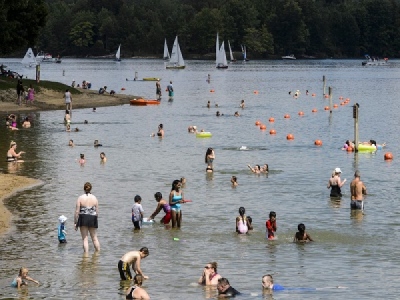
Posted on July 10, 2017
By Rick Steelhammer, Charleston Gazette-Mail
With annual visits in the 1 million range, an 800-person, 10-year-long waiting list to rent marina slips, parking issues and localized boating congestion, Summersville Lake, West Virginia’s largest and most popular body of water, needs help to plan for its future.
That’s why personnel from the Huntington District of the U.S. Army Corps of Engineers are holding a series of public meetings with lake users to come up with a new master plan aimed at solving existing problems, heading off new ones, and finding new ways to enhance recreation at the 2,790-acre reservoir, its 60 miles of shoreline and nearly 4,000 acres of surrounding Corps-managed land.
“Our current master plan dates back to the early 1960s, before construction of the lake was completed,” said Dan Bock, landscape architect for the Huntington District, and the man in charge of collecting information for an updated plan for the popular reservoir.
“It would have been hard to anticipate future needs back then, before the first boat was in the water,” Bock said. “This time, we have the advantage of a half-century of lake use to look at,” he said, not to mention a vast group of lake users to consult with, in determining how to keep the lake a beloved attraction for future generations.
Summersville Lake opened to recreational users in 1966, following a dedication ceremony in which President Lyndon B. Johnson correctly predicted that “millions in years to come will enjoy” spending time at the reservoir. The lake was created by damming the Gauley River primarily as a flood control project to protect the Kanawha Valley.
While boating, fishing and camping were correctly envisioned as the main recreational activities for the reservoir in the original master plan, a number of then-unforeseen activities have emerged and gained popularity since then. They include scuba diving, due to the lake’s exceptionally clear water and depths of up to 300 feet, supported by a lakeside dive shop; rock climbing, with 350 routes and ascents ranging from 30 to 100 feet; stand-up paddleboarding and flat-water kayaking.
Even the traditional user activities have changed since the ’60s.
“The typical boat size when the lake opened was in the 16- to 18-foot range,” Bock said. “Now the boats are bigger, along with the trailers that carry them and the vehicles that tow them,” which chews into the parking space initially thought to be adequate. Those working on the initial master plan also had no way to foresee the development of the Jet Ski, a key element of today’s boating mix, let alone the stand-up paddleboard, for which Summersville Lake is a popular training and touring area.
Summersville Lake’s current amenities include three boat launch ramps; a marina and dive shop; a campground with 110 power-equipped sites for RVs and camp trailers and seven walk-in sites for tent camping; two bathhouses; a 1,000-foot swimming beach; picnic shelters and a small assortment of hiking and biking trails.
Based on analyses of roadway vehicle counting gear, between 750,000 and 1.1 million people visit Summersville Lake annually.
Among issues of concern identified in March during an initial public meeting for the new master plan, which drew about 70 lake users, were insufficient parking at lake access points, limited access roads to the lake, localized boating congestion and a need for additional hiking and biking trails.
At a follow-up meeting held last week in Summersville, issues voiced by some of the 50 lake users in attendance included the long waiting list for slips at the marina; a shortage of access points to the DNR-managed 5,390-acre Summersville Lake Wildlife Management Area surrounding the Corps of Engineers’ 3,956 acres of recreational land; traffic congestion and parking conflicts at the Long Point Marina; inadequate restroom facilities at the Salmon Run boat launch area; the possibility of adding water and sewer service to campsites at the Battle Run Campground and inadequate access to rock climbing areas.
Discussions also covered the possibility of developing an additional boat ramp at the existing Muddlety canoe and kayak launch site, developing an interpretive area atop Summersville Dam to explain its role in flood management and recreation, managing timbering activity on Corps property to create new hiking and biking trails, limiting space at the marina to one slip per person and setting a time limit on how long each individual can rent a slip.
Bock said a series of aerial surveys of boating traffic on the lake is underway to map areas of congestion and get an accurate assessment of boating numbers. Data from that survey is expected to be useful in determining whether the lake has the capacity to add more marina slips or additional launch sites and still maintain an enjoyable boating experience.
The planning effort now underway is designed to address recreational and ecological concerns over the next 20 years. It is expected to be complete by the end of 2019. By identifying specific goals for the lake and the rationale for achieving them in the master plan, “we can be ready to move forward when and if money becomes available,” Bock said.
This year, “we’re collecting data and getting input from the public,” Bock said. “Next year, we will analyze the issues that have come up and try to find solutions for them, and look at the opportunities we have identified and try to take advantage of them. During the third year, we will be assembling and reviewing the plan.”
The next public meeting on the Summersville Lake master plan will take place in September. Click here for more information on the master plan and to watch for upcoming public meeting dates.
Source: Charleston Gazette-Mail





